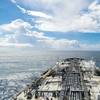The 900,000bb FPSO (floating production, storage, and offloading unit) Farwah, to be
operated in offshore block C137, 100 km offshore Libya, was launched at IZAR’s Fene yard, according to schedule, on October 7.
Partners in the development of the offshore block C137, known as the B structure, are TotalFinaElf, Germany’s Wintershall, and Libyan National Oil Company (NOC) with the balance.
TotalFinaElf affiliate Compagnie des Petroles Total Libya (CPTL) is operating the project, which is based in 272 to 285 ft. water depth, 62 miles offshore western Libya.
Construction of the FPSO Farwah was started at Fene yard less than one year ago, after
in mid-2001 Antwerp-based Exmar Offshore was contracted to supply the FPSO on a leased basis to CPTL and to manage production operations.
The yard – formerly operating under the Astano brand – has a solid track record in offshore hull construction and outfitting. Over the past decade, the yard delivered FPSOs for the Gryphon, Foinaven, and Captain projects in the UK sector, the floating storage unit (FSU) for Chevron UK’s Alba development, and three newbuild deepwater drillships for Transocean Sedco Forex. It has more experience than any other yard in Europe in adapting its construction schedules quickly, which is a pre-requisite for most fast-track FPSO projects.
As regards 137-B, Fene is responsible for the design, engineering, and construction of the hull, as well as the engineering interface with the turret and topsides modules. It has also manufactured certain equipment items for the engine room and deck, in association with other IZAR yards in Spain.
As Project Manager Jorge Lopez Novo says, “We were first approached about this project in August 2000. At that time, Exmar was focusing on a conversion, at TotalFinaElf’s
request, although a newbuilding was also an option.
“In late September 2000, we were submitting our proposal for a newbuild FPSO, having
put together a detailed basic design in just four weeks. In fact, the main parameters for the
vessel have not changed much from that document. Afterward, a clarification process
followed, mainly concerning the scope of work, as our estimate varied from what Exmar had
in mind for a conversion.”
The completed vessel has a length of 689 ft., a breadth of 144 ft., a depth of 75 ft., and a
design draft of 54 ft. When fully laden, it will have a deadweight of 147,700 tons. The
vessel will be able to weathervane 360 degrees around its turret.
The harsh local environment necessitates strengthening of certain support structures. To
aid stability, 196-ft.-long bilge keels are being fitted along the vessel’s sides. At the front of the vessel, a high bulwark will be installed to protect the deck from green water.
IZAR Fene designed and fabricated the 300-ton hydraulic power module, which is used
to drive the offloading pumps.
“One of the main considerations in the topsides layout is to facilitate access to the cargo
pumps,” says Jorge Lopez. “These are designed to discharge crude at up to 5,000 cum/hr. In
total we will have 12 pumps, each capable of operating at 1,250 cu m/hr. There will be 12
cargo tanks in the deck’s lower level, each with the same capacity. In the central area, there
will also be four side ballast tanks.
“The engine room has been situated below the accommodation in a 66 x 131 ft. space. We
have configured the design as much as possible to suit operations and maintenance tasks.
Certain equipment items have been specially located to meet noise/vibration requirements.”
IZAR’s yard in Cartagena, southern Spain, has fabricated the power plant’s 3 MW diesel
generators. IZAR Manises in Valencia has built two, 30-ton cranes for the deck, while Fene
built and designed the helideck and accommodation area (enough for a crew of up to 52) and
the 98-ft. flareboom.
All main modules were delivered to Fene in July and August, with the metering equipment installed at the same time.
Since last October, most of the interface planning has been conducted from Fene. “The
outfitted vessel will sail out to the field next January under tow,” says Lopez. “Sailing time
should be around one month.
“At peak, we will have employed maybe 800 people here on this project, involving 1.3 million manhours.”
To speed up contracts such as this, Fene recently invested in new workshop areas. It now
has two independent fabrication flows (covered floors). Fene also invested $15 million in two
new paint shops dedicated to top coating.
”These extra facilities allow us to do more painting simultaneously and more quickly.
“Three years ago, we also upgraded our pipeshop and handling equipment, which further
improves productivity. In the flat panel assembly line, we have installed additional welding
equipment, which allows us to achieve eight welds at the same time.
“We have installed new plasma-cutting machines, which doubles our cutting capacity.
And finally, we have a traveling crane that allows us to unload incoming modules from our
quay and bring them back to the yard in a single lift.
“All these moves could reduce the time for such an assembly operation by up to 30 percent,
compared with what we were achieving in 1997.”
Sponsored Content
Chris-Marine’s solutions help to prolong engine lifetime

Subscribe for
Maritime Reporter E-News
Maritime Reporter E-News is the maritime industry's largest circulation and most authoritative ENews Service, delivered to your Email five times per week










